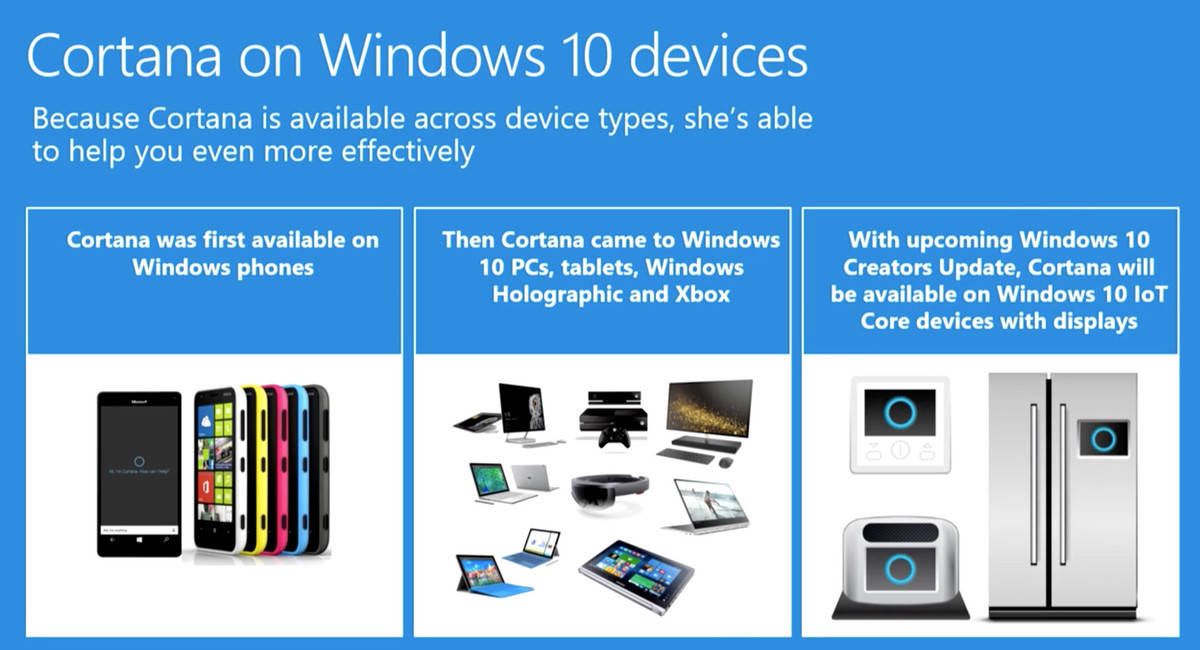It’s all starting to come together.
Project Evo and Windows 10 on ARM are two very important projects that help lay the foundations for Home Hub, Microsoft’s up and coming Windows 10 feature that aims to make Windows 10 PCs the center of your home. We recently blew the lid off everything Microsoft has planned for Home Hub, but with the likes of Amazon Echo and Google Home storming the “connected home” and “virtual assistant” market, many of our readers were questioning whether Microsoft’s vision for this market is the right one.
Home Hub aims to turn any Windows 10 PC into a hub for everything in your home. It’ll allow you to control your smart home devices with Cortana, and Cortana will be able to differentiate between different family members thanks to Windows Hello. There’s so much more to it, but in short, devices that utilize Home Hub will be viable and active competitors to the likes of the Amazon Echo and Google Home. The only difference being these Home Hub devices, at least at first, will require some kind of screen to function.
This requirement of a screen was recently confirmed at WinHEC, as Microsoft still needs to do some work with Cortana before she’s able to function only by voice. It does appear some hardware makers are getting around this requirement however, as a recent device announcement from Harman Kardon appears to showcase some kind of Cortana speaker, and it’s unclear at this time whether this speaker has some kind of screen. Regardless, Microsoft wants Home Hub devices to utilize a screen at first, and oddly that appears to be a problem for some people.
Now of course, Windows 10 on ARM and Project Evo aren’t just for Home Hub, they’re for any kind of Windows 10 device you can think of. But these two projects do benefit Home Hub devices immensely, as it allows hardware makers to build devices that were not possible before.
The biggest complaint that I saw from readers was that devices with screens will likely draw more power when idle/sleeping, and considering a lot of these Home Hub devices will be full PCs underneath, that’s a significant amount of power being drawn compared to the likes of the Amazon Echo, which doesn’t use a crazy amount of power. This issue is resolved with Windows 10 coming to ARM, in theory, as ARM powered devices — even with screens, draw very little power.

ARM devices can come in all shapes and sizes, not just tablet/laptop form. If a hardware maker wants, they could build a full AiO powered by an ARM chip, that’s super thin, looks gorgeous and works great as a Home Hub device. They could build an ARM powered fridge, with a huge 40-inch screen on the door. Home Hub’s Welcome Screen is meant to ape the role of the refrigerator door — with ARM it could literally be the refrigerator door.
Traditional PCs also aren’t that great at the “always connected” aspect that we’d expect out of something like a Home Hub device. Connected standby is great, but it doesn’t really work for those who want to be able to wake up devices with their voice using Cortana, or have Cortana always listening even when the device is in sleep mode. Project Evo tackles these problems too, by allowing OEMs to build devices that, even when idle, will always be listening and ready to take queries with voice. This will be a huge bonus for Intel-powered PCs, as it means they can function similarly to that of ARM based devices that are already able to always be listening. ARM, naturally, is already equipped to handle those demands.
Also on the list of complaints: some were upset at Microsoft for making this a thing for PCs. Amazon Echo and Google Home are dedicated devices that don’t look or act like PCs, whereas Home Hub is designed to run on PCs. While this is true, Home Hub devices don’t necessarily have to be PCs. Sure, it can run on PCs, but it can also run on IoT devices, laptops, and tablets. Not only that, but with Windows 10 coming to ARM, hardware makers can finally begin looking at building super thin, long lasting, unique devices that don’t resemble PCs at all.

And I think that’s where the most exciting prospect of these recent announcement are. Hardware makers now have the opportunity to build incredible, innovative devices that were not possible just a few months ago. Home Hub will be able to take advantage of these hardware innovations, and it should open the door to a whole market of smart-connected devices, powered by Windows 10 and Cortana.
Microsoft is serious about getting into the “virtual assistant” market with Cortana, and with Windows 10 Home Hub devices coming in 2017 and 2018, it won’t be long before we see what hardware makers have to offer. We’ve already had a teaser from Harman Kardon showcasing some kind of Cortana speaker, and it looks real nice. We should be expecting more of that, as well as even more unique and crazy kinds of devices, to show up in the future thanks to Windows 10 on ARM and Project Evo.